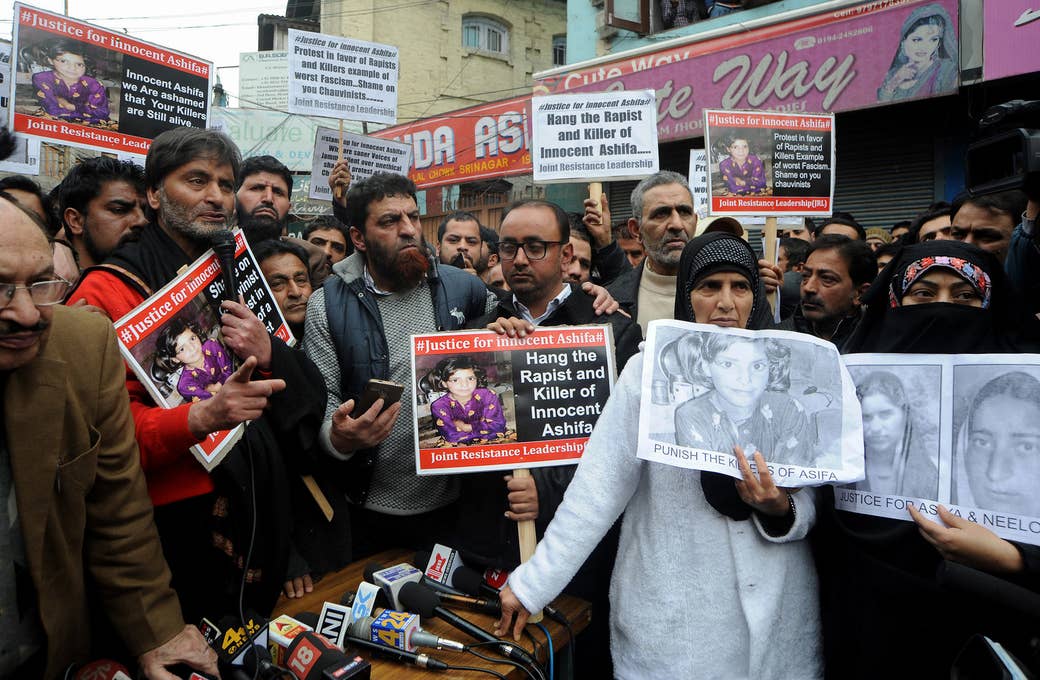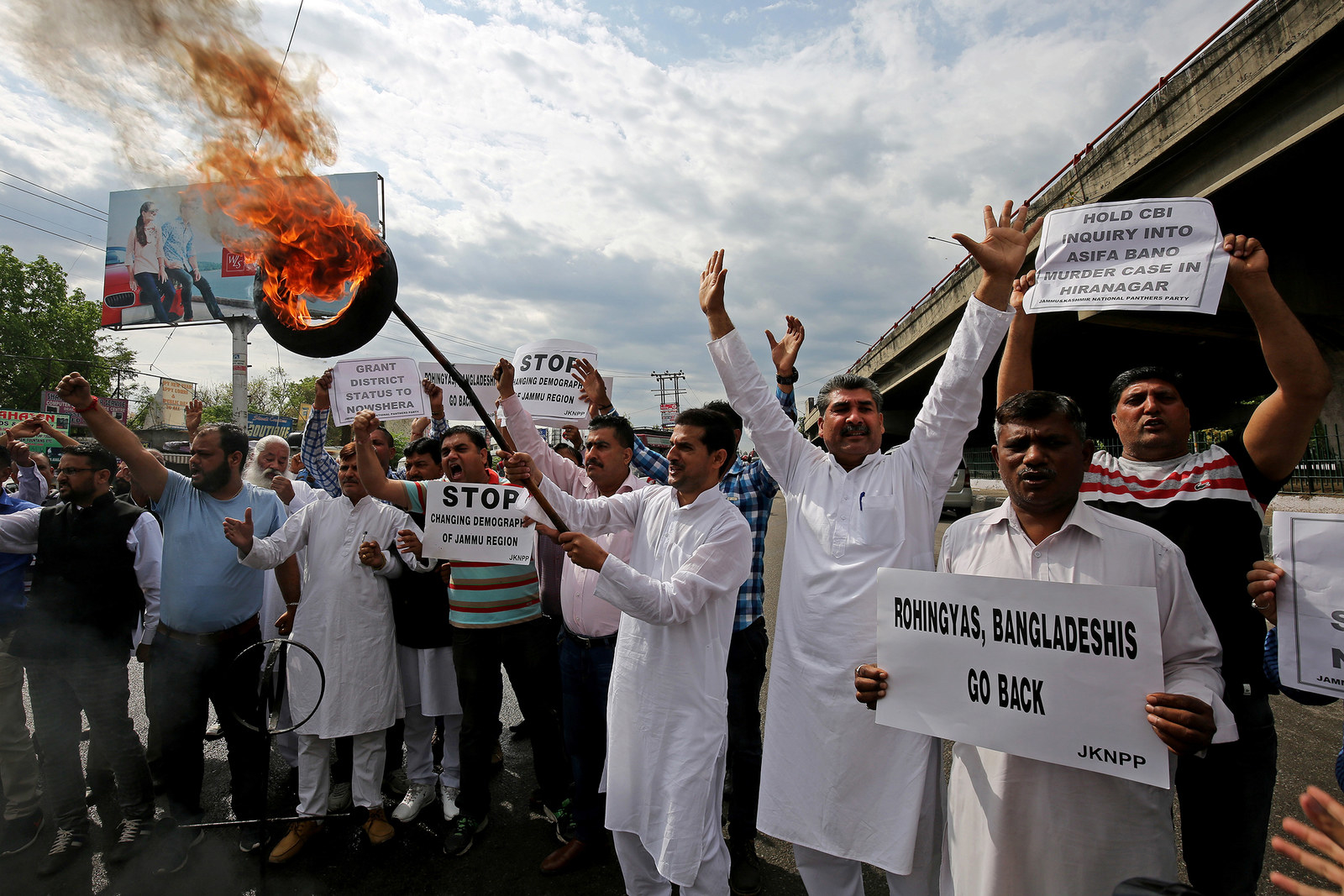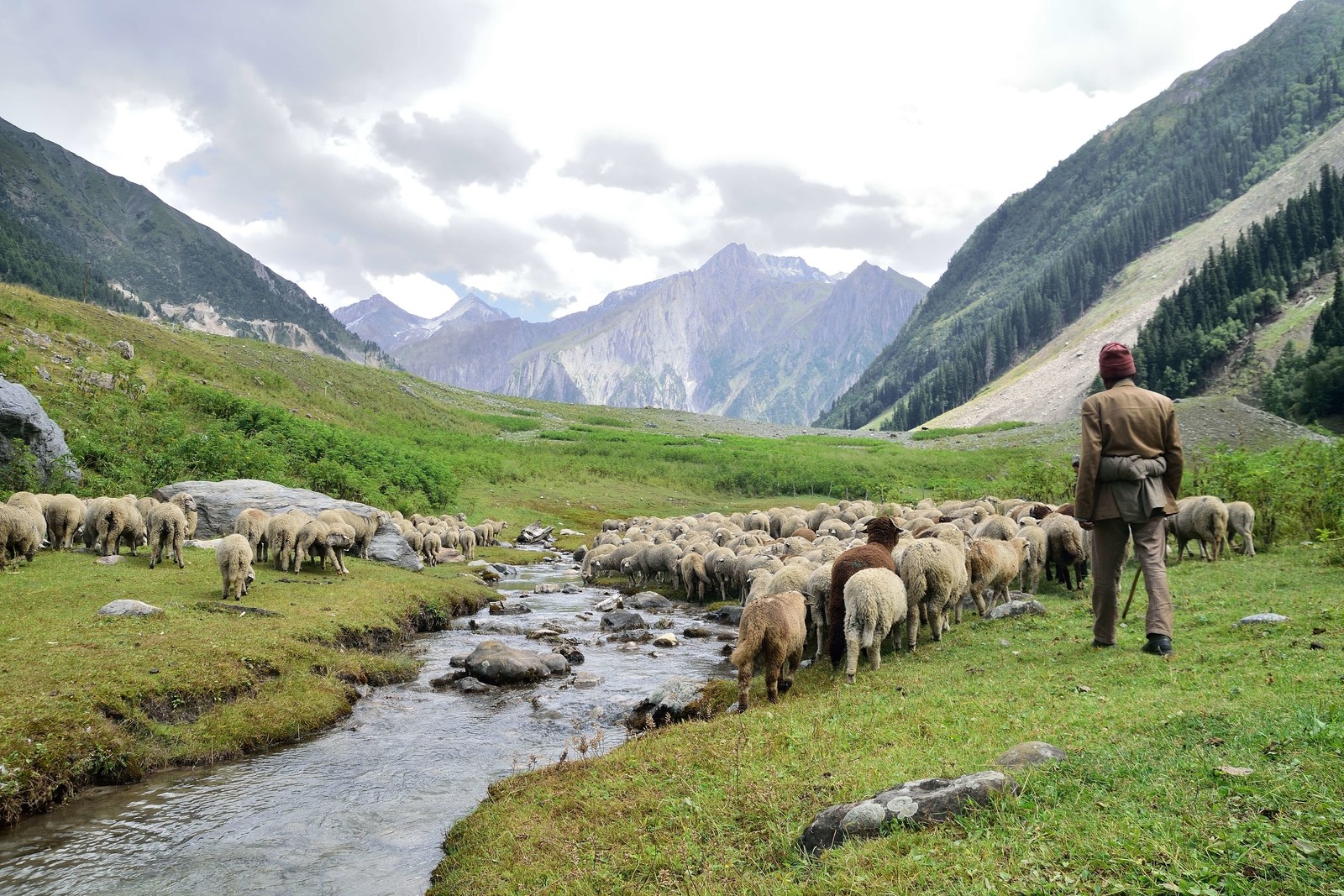
NEW DELHI — The abduction, rape, and murder of an 8-year-old girl allegedly overseen by a retired government officer has outraged India and thrust the country’s pervasive rape culture into the limelight once again.
According to a police report seen by BuzzFeed News, the victim was kidnapped in Northern India on Jan. 10, drugged, starved, locked up in a temple, and raped repeatedly by multiple men before she was killed a week later.
Protests are being organized across the country over the murder, and a deluge of angry and heartbroken poems, illustrations, and messages for her have appeared on street corners and social media.
People demanding justice for the girl is the largest public outpouring of grief of this kind in India since a 23-year-old student was gang-raped on a bus in New Delhi in December 2012.
“Our daughters will definitely get justice."
The ruling Bharatiya Janata Party is scrambling to match public anger over the murder in Kathua, in the state of Jammu and Kashmir. On April 13, three months after she died, Prime Minister Narendra Modi said such incidents had no place in civilized society. “Our daughters will definitely get justice,” he said.
The Minister for Women and Child Development Maneka Gandhi has also said that she plans to make the rape of children below 12 punishable with a death sentence.
But these measures now seem too little, too late.
The victim belonged to the Bakarwal community, a nomadic pastoral tribe, who are primarily Sunni Muslims. Much of the anger over the story is based on the fact that the 8-year-old seems to have been the victim of a conspiracy centered around the greed for land, and a deep hatred of Muslims in Modi’s India.
Two days after the girl's death, a Hindu teenager confessed that he had abducted and attempted to rape her, murdering her only because he was afraid that her family would kill him for revenge. Further investigations by a special investigative unit (known as the Crime Branch) eventually uncovered what they say is the role played by at least three police officers in carrying out and covering up the crime. These officers, like the teenage boy, are also Hindu.
(None of those arrested in the case have been formally charged yet.)
The girl's story has thrown India’s communal politics into sharp relief: As the Crime Branch prepared to take their report to court, they were obstructed by lawyers chanting pro-Hindu slogans. Now, as the case is being prepared for trial, Deepika Singh Rajawat — the woman lawyer who will be representing the victim's case — has been threatened by the president of the bar association and warned not to appear in court.
The fact that the girl and her family are Muslim, while her alleged murderers are right-wing Hindus, has also eclipsed any conversation on rape culture or the harassment of minority communities like the Bakarwals.
But ultimately this is the story of a terrible crime inflicted upon a young girl.

The police report for which the investigative team interviewed and recorded the testimonies of 130 witnesses, and collected forensic and medical evidence, call records and cell phone locations, reveals a chilling picture of the organized fashion in which the accused allegedly hatched a plan, selected allies, assigned duties, paid off police officials, and executed the murder of an 8-year-old.
The report says the teenager who confessed to the crime on Jan. 19 — who cannot be named for legal reasons — was part of a wider conspiracy around the girl's abduction, rape, and murder.
The plan, police say, was originally hatched by the teenager’s 60-year-old uncle, Sanji Ram, at the beginning of the year, when the teenager first came to live with him.
Ram is described in the police charge sheet as a retired man with a record of harassing the Bakarwals; he would meddle in their land deals, and seize their cattle.
Ram had also found allies in a couple of local police officers — Head Constable Tilak Raj and Special Police Officer Deepak Khajuria. The police officers routinely picked fights with members of the tribe, and during the investigation they told officers that they believed the Bakarwals engaged in “cow slaughter” — a dog whistle for anti-Muslim sentiment in India — and, ironically, “peddling drugs to children.”
According to the teenager’s testimony, Ram started to poison his nephew with hate-filled conspiracies against the Bakarwals. One day, Ram is supposed to have told him that the best way to teach the Bakarwals a lesson would be to abduct the girl (whom he had often seen in the forest, tending to her horses), drug her, and trap her in a local temple.
The teenager told police that he initially resisted his uncle’s plans, but he was convinced when Khajuria, one of the police officers, offered him some cigarettes, and told him that if he managed to kidnap the victim, they would help him cheat and pass his school board exams. Convinced, the teenager enlisted another friend, named in the report as Parvesh Kumar, to help him execute the plan. The next day, the two friends allegedly purchased some over-the-counter drugs.
The report says that the teenager encountered the victim on Jan. 10 as she looked for her horses. According to police, the teenager told the girl he knew where the horses were, and took her to the temple where Kumar was waiting for them.
The police report says the two young men — apparently acting out of a desire to pass their school exams — drugged the girl until she was unconscious, after which the teenager raped her. They tied her up and locked her in the temple alone.
The day after the girl disappeared, her father, Muhammad Yusuf Pujwala, showed up outside the locked temple where his daughter was being held, still alive, and asked Ram if he knew the girl's whereabouts. On Jan. 12 he filed a complaint at the same police station where Khajuria was based, saying that he believed his daughter had been kidnapped.
Once the victim's father left the police station, the police report alleges that Khajuria visited the temple with over-the-counter psychiatric pills that Ram had advised him to buy a few days prior. Drugging the girl so she would be unconscious once more, Khajuria also proceeded to rape the child, according to the report.
In the week that followed her disappearance, the girl's family, who knew the forests of Kathua better than most, repeatedly traced their paths around the forest, looking for any sign or trace of the child. Meanwhile, Khajuria also kept up the pretense of searching for the child in the village.
The report says that in the week she was held captive, the victim was raped multiple times by the men. The teenager, who lit the lamps at the temple every evening, contacted Vishal Jangotra, Ram’s son, to come and join him in raping the girl. Jangotra took a train from Uttar Pradesh, 17 hours away, to arrive at the temple in Kathua where the victim was trapped. The police report says Khajuria then also showed up at Ram’s house under the pretext of looking for the missing girl, demanded money to pay off investigating officers, and asked Ram’s nephew to prepare the girl for his arrival with a fresh round of drugs.
According to the charges levelled against them in the police report, a few days before the girl's body was found in the forest, Ram instructed the men that they needed to kill her. After raping her one last time, they strangled her and then hit her over the head with a large stone.
The teenager was arrested two days later, on Jan. 19. By then, news of the girl's death and the brutalized state that her body was found in had caused a political scandal: Leaders of the local opposition demanded that the police officers investigating the case be fired immediately. The girl's death was held up as evidence that minorities were no longer safe in Jammu. Hundreds of Bakarwals protested in different parts of the state. Imams at the mosques in Ramban, Khari, and Banihal warned the government that they would have a full-scale agitation on their hands if the killers were not found.
To deal with all the attention on the case, the police report states that Khajuria told Ram he would attempt to pin the murder on another tribal man, who was in police custody at the time for a separate crime.
But when he was interrogated by the police, Ram’s nephew said the crime was his alone. He described how he had abducted the girl and held her captive in a cowshed, making no mention of the temple. He said that he made sure no harm came to her — he fed her, cleaned her up, tied her up again for a week — until he decided it was time to drop her home. The teenager admitted that he tried to rape the girl when he was finally walking her back home through the forest. Scared by her threats that the Bakarwals would find and kill him, the teenager said he panicked and ended up killing her by dropping a rock on her head.
As a juvenile offender, the teenager would have received a lesser punishment for the crime. But investigations by the police revealed no traces of him or the girl in the cowshed he had mentioned, or on the rock he claimed he had used to kill her. Despite this, late on Jan. 19, the police claimed they had solved the crime, and that a juvenile boy had confessed to the murder.
The girl's death and the national conversation around it had turned distinctly communal by this point — a young Muslim girl had been brutally killed, and the government appeared to be looking for a way to close the investigation as quickly as possible, no matter how improbable it seemed that a lone teenage boy was responsible for the state that the victim's body was found in — limbs broken, bite marks on her face and shoulders.
In Jammu, the chief minister’s political opponents would not let the matter rest. As the protests across the state showed no signs of letting up, the case was finally transferred to the Crime Branch on Jan. 23, leading to the charge sheet we have today.
A Hindu boy had killed a Muslim girl, and now that the case had been transferred to a separate investigative unit, the Hindu right wing decided to play on Hindu–Muslim tensions to stage a protest of their own in Jammu, against the Muslim Bakarwals. One such right-wing group, the Hindu Ekta Manch, insisted that the case be investigated by the Central Bureau of Investigation instead of the State Police’s Crime Branch, which, they said, appeared to be “going after innocent Hindus.”
On March 3, NDTV, an Indian news channel covering the protests, aired a clip of an elderly protester dressed in a black sweater, wearing rectangular spectacles and a smudge of vermillion on his forehead. It was Ram. By March 20, the Crime Branch’s investigation had named him as the chief conspirator in the abduction, rape, and murder of the victim.

In Jammu and Kashmir, a single, troubled state in a region claimed by both India and Pakistan, the complex intersection of religion, geopolitics, and India’s history of human rights abuses in Kashmir have turned the girl's death into a polarizing national issue.
In Kathua, the Bakarwals had found themselves under constant attack, not just from Ram, but also the state authorities and local right-wing groups. The state’s construction plans meant that the tribe was often forcibly relocated from their homes into narrow tracts of land where the Bakarwals’ cattle could not graze. After the girl's death, her family could not even find a piece of land to bury their daughter in Kathua. Now the Bakarwals are migrating once more.
This time, it’s not the weather that’s driving them further into the mountains, and chances are they will not return.
NOTE
This post was updated on July 11, 2018 to remove all mentions of the victim's name in compliance with Indian law.

